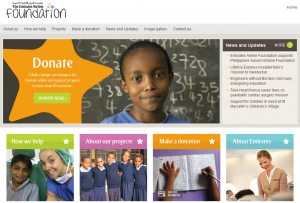
The Emirates Airline Foundation, launched in 2003, is a non-profit organization formed by the Emirates airline. It aims to provide healthcare, food, education and housing for disadvantaged children across the network covered by the airline. It is run under the patronage of His Highness Sheikh Ahmed bin Saeed Al Maktoum, the chairman and chief executive of the Emirates Airline and Group. Decisions regarding which projects are to be targeted rest with the board of directors, comprised of senior Emirates Group management. For the purposes of this research attention will be paid to a number of the Foundation’s activities that are specifically concerned with healthcare.
The projects are primarily located at destinations within the Emirates network as this facilitates the voluntary contribution of local airline staff to the projects and initiatives. The staff work in many cases with assistance from local communities.
In addition to its own charity activities, the Foundation encourages donations of Skywards Miles by its passengers; these loyalty scheme points contribute to complimentary airfares for doctors and other aid workers travelling on humanitarian missions. Global organizations which have benefitted in this way include Operation Smile, Operation Straight Spine, Australian Doctors for Africa and Global Nurse Initiative and many others.
The Lady Ridgeway Hospital for Children, Colombo, Sri Lanka: the Foundation’s work began here in 2008 with the provision of repair and funds for the hospital’s intensive care unit. The unit has been entirely refurbished with new furniture and equipment. More recently a vacuum plant has been installed which supports life-saving equipment. Medical disposables are also provided and due to the facilities now in situ many more children are being treated successfully and mortality rates are dropping. In September 2014 the Foundation donated a new ambulance to the hospital.
( SDG 17, Partnerships for the Goals)
Fikelela: Fielela, meaning ‘reach out’ in Xhosa, is an outreach program running in South Africa to serve disadvantaged. It was founded in 2000 and is situated in Mandela Park, Khayelitsha. It focuses particularly on the nursing back to health of abandoned, neglected or orphaned children; they are provided with anti-retrovirals and offered educational and development programmes. Fikelela aims to reunite children with their families, or when this is not possible place them in foster homes which are screened and monitored by social workers. (SDG 3, Good Health)
The Emirates Friendship Hospital Ship: This floating hospital provides medical assistance to more than two million people affected by monsoon flooding in the most deprived region of Bangladesh. The Foundation financed the vessel for Friendship, the registered NGO which runs the hospital. The facility covers a 250 kilometre long stretch of the River Brahmaputra which is an area renowned for its inaccessibility and lack of medical aid. The hospital is equipped with primary health care facilities, two operating theatres, two eight-bed wards, and various specialist units. Free medicine is provided by the dispensary. In the period January – September 2014 over 50,000 patients were treated on the ship. (SDG 3, Good Health)
Herewith a collection of international case studies of best practices. We have selected cases from different regions and various industries, to showcase importance of strategy and implementation working hand in hand. As reality evolves and lessons are learned, improvements are discovered and organisations adapt their strategies to achieve an ever-greater impact. Ultimately, best practice, by definition, will need to adapt, so that the original definition is not negated and optimum performance is maintained. On the other hand, organisations consist of people who learn from experience and may change their strategy to achieve greater results. We have no affiliation with all the brands and cases depicted. The idea behind the concept of best practice is that not only is the practice concerned a superior way of doing something but, by definition, it will always be considered as being “the best”, in that it is an optimal practice and the way something should be done at any point in time.

